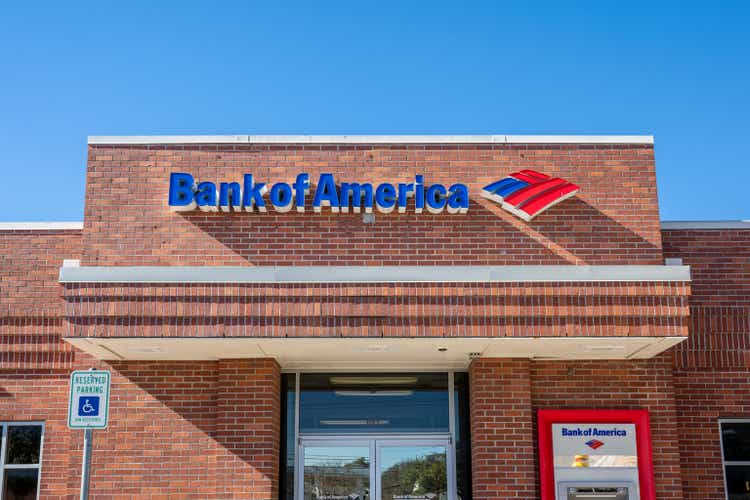
Brandon Bell
Bank of America Corporation (NYSE:BAC) or BofA investors received a delightful early Christmas gift from Santa, as BAC has significantly outperformed the S&P 500 (SPX) (SPY) since my previous update in September 2023. I urged investors to capitalize on the implied pessimism in BAC's valuation, as those attractive levels "might be gone if investors waited."
Accordingly, BAC notched a total gain of nearly 38% from its late October lows through last week's highs. As a result, investors who leveraged on BAC's peak pessimism in late October have outperformed the market significantly. Note that BAC bottomed out well before Fed Chair Jerome Powell telegraphed three possible rate cuts in mid-December. As a result, it's critical for investors to anticipate, as the market is forward-looking. By the time the Fed informed everyone: "Hey, we are going to cut rates next year," the most attractive buy levels are gone.
With BAC's valuation having normalized, I believe it's timely to assess the risk/reward appeal of BAC at the current levels for investors who missed buying at its October lows. BAC last traded at a forward adjusted P/E of 10.5x, slightly below its 10Y average of 11.5x. As a result, it's arguable that its valuation profile seems more well-balanced, corroborated by Seeking Alpha Quant's "C+" valuation grade.
Management updated in a recent conference that it doesn't expect a recession, suggesting its October lows (adjusted forward P/E of 8x) are expected to be its cyclical lows. As a result, the market would likely shift its focus to BofA's core earnings growth drivers over the next two years as the high interest rates regime normalize.
BofA telegraphed that it doesn't expect the rates to return to the pre-pandemic lows, suggesting a higher-for-longer rate environment is expected to persist. Despite that, it expects rate cuts "totaling 150 basis points" through 2025. Notably, these aren't expected to impact the bank's NIM drastically. In contrast, BofA anticipates improved NIM dynamics, suggesting that the "restoration of higher rates can lead to an expansion in the NIM from around 2.30% to 2.40%."
BofA's NIM resilience can be attributed to the strength of its deposit franchise, which is mainly focused on transactional cash. As a result, it can continue to borrow short at relatively low interest rates, bolstering its earnings profile and visibility. With that in mind, management remains confident about a bottom in its NII growth in 2024 before an upward inflection in H2. BofA also reminded investors that the bank has considered lower rates in its forecasts, suggesting further near-term revisions to its estimates due to the Fed's rate cuts aren't likely.
Wall Street analysts anticipate a near-term adjusted EPS decline in 2024 by 4.9%, considering the tough comps driven by the tailwinds from high interest rates in Q4'23 and Q1'24. As a result, most of the downside risks on its EPS growth should reach its peak in the first half, in line with management's expectations. In other words, investors shouldn't expect a structural decline in its EPS growth trends, with the boost expected to resume in the second half of 2024. As a result, analysts penciled in a return to growth in 2025, projecting an adjusted EPS increase of about 4.6% YoY.
With that in mind, BAC last traded at an FY25 adjusted EPS multiple of about 9.7x, which isn't expensive relative to its 10Y average of about 11.5x. Near-term risks include expected changes in the regulatory regime lifting capital requirements but should impact the smaller ones harder. In addition, heightened competitive risks could also lead to reduced earnings visibility on BofA and its leading money center peers. Despite that, BofA underscored its confidence in meeting these requirements. As a result, management doesn't expect these requirements to impact its capital allocation strategies or risk profile materially. Also, BofA sees "no need to raise capital or change the balance sheet to meet these requirements."
With that in mind, the market was right to re-rate BAC's valuation profile upward, considering a more constructive interest rate environment that previously affected its relatively large HTM securities portfolio. In addition, the market has likely considered lower earnings visibility risks due to the regulatory changes and lower implied downside risks due to a hard landing (which isn't the base case).
While I believe a near-term pullback is justified, its 1Y total return of 4.8% is still well below its 10Y CAGR of 9.8%. In addition, BAC seems ready to resume its long-term uptrend bias, suggesting that the opportunity for buying into BAC remains relatively early. While the "best" buy levels aren't expected to return, I believe the risk/reward for BAC remains attractive at the current levels.
As a result, investors shouldn't be fooled into unloading BAC (unless reallocating capital to relatively more attractive setups) at the current levels just because it staged a remarkable recovery from its October lows. With my Strong Buy thesis playing out, I have decided to lower my rating by one level to Buy.
Rating: Revised to Buy.
Important note: Investors are reminded to do their due diligence and not rely on the information provided as financial advice. Please always apply independent thinking and note that the rating is not intended to time a specific entry/exit at the point of writing unless otherwise specified.
We Want To Hear From You
Have constructive commentary to improve our thesis? Spotted a critical gap in our view? Saw something important that we didn't? Agree or disagree? Comment below with the aim of helping everyone in the community to learn better!
"stock" - Google News
December 24, 2023 at 01:00AM
https://ift.tt/FxNGIm0
Bank of America Stock: Don't Be Fooled Into Getting Out This Early (NYSE:BAC) - Seeking Alpha
"stock" - Google News
https://ift.tt/pAf9iDj
https://ift.tt/MYJnOzf
Bagikan Berita Ini














0 Response to "Bank of America Stock: Don't Be Fooled Into Getting Out This Early (NYSE:BAC) - Seeking Alpha"
Post a Comment